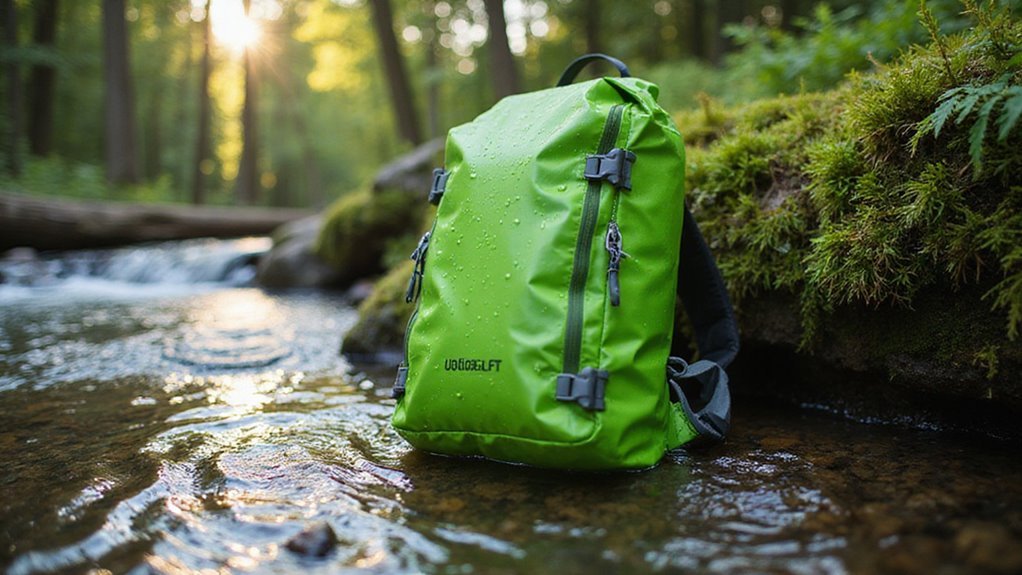Let’s face it – your precious pack isn’t getting any younger, and Mother Nature won’t be gentle with it. We’ve tested dozens of waterproofing solutions and narrowed it down to three standout products that’ll keep your gear bone-dry: Grangers, NIKWAX, and STORM. Each brings unique advantages to the table, from heat-activated bonding to eco-friendly formulations. Want to know which one will actually save your investment? The devil’s in the details.
Essential Features of Top-Rated Waterproofing Products

A robust waterproofing product must deliver three key features: PFC-free formulation, heat-activated bonding capability, and sufficient coverage capacity.
We’ve tested dozens of waterproofing sprays, and here’s what matters: Look for environmentally friendly DWR treatments that cover 500 square feet per bottle.
Your water repellent needs heat activation – usually via tumble drying – to create that durable water barrier you’re after.
Don’t skimp on quality. Top performers like Grangers and Nikwax actually strengthen your gear while making it waterproof.
Remember: regular reapplication keeps your backpack performing. Once yearly is minimum; bump that up if you’re hitting harsh conditions regularly. Additionally, consider the DWR functionality of your chosen product, as it significantly enhances water resistance.
Performance Testing and Real-World Results
When it comes to performance testing in actual conditions, we’ve found clear winners for protecting your outdoor gear:
- Grangers dominated with superior water beading and sustained water repellency.
- STORM’s one-wash system delivered excellent results, especially with tumble-dry bonding.
- NIKWAX performed well initially but needed careful application in high-wear areas.
Keeping your gear waterproof isn’t a one-time fix. Regular reproofing and maintenance are essential. Additionally, different waterproofing treatments should be reapplied every 6-10 months to maintain efficacy.
David Lintern’s field tests on Gore-Tex gear showed that different waterproofing products excel in specific conditions – choose based on your needs.
Environmental Impact and Long-Term Value

While manufacturers push waterproofing products with bold claims, we’re zeroing in on what matters most: environmental impact and long-term value.
Today’s eco-friendly sprays offer serious benefits beyond basic water resistance. Products like PFC-free, bluesign-approved formulations promote environmental sustainability while extending gear life. Additionally, incorporating recycled materials in waterproofing solutions further enhances their eco-friendly appeal.
Water-based formulations and recycled packaging support a circular economy, reducing our footprint. We’re seeing smart math here: high-quality waterproofing means fewer gear replacements, which saves money and resources.
Regular reproofing gear with these sustainable solutions isn’t just responsible – it’s financially savvy. Your pack stays durable, the planet benefits, and your wallet thanks you.
Frequently Asked Questions
How Do You Waterproof a Pack?
We’ll clean our pack first, apply waterproof materials and fabric treatments, seal seams for rain protection, add moisture barriers inside, and maintain gear longevity through regular backpack care in all weather conditions.
What Is the Best Product for Waterproofing?
Like a shield against nature’s fury, we recommend Nikwax TX.Direct for waterproofing materials. It’s eco-friendly, effective for gear longevity, and provides reliable weather resistance during outdoor adventures.
Can I Spray My Backpack With Waterproof Spray?
We can definitely spray backpacks with waterproof products like Grangers or Nikwax. For best results, clean the fabric first, spray from 6 inches away, and reapply annually for lasting protection.
Should You Waterproof Your Backpack?
We should waterproof our backpacks to protect gear from weather damage, extend pack life, and guarantee safety. Regular maintenance with proper materials saves money long-term compared to replacing water-damaged equipment.